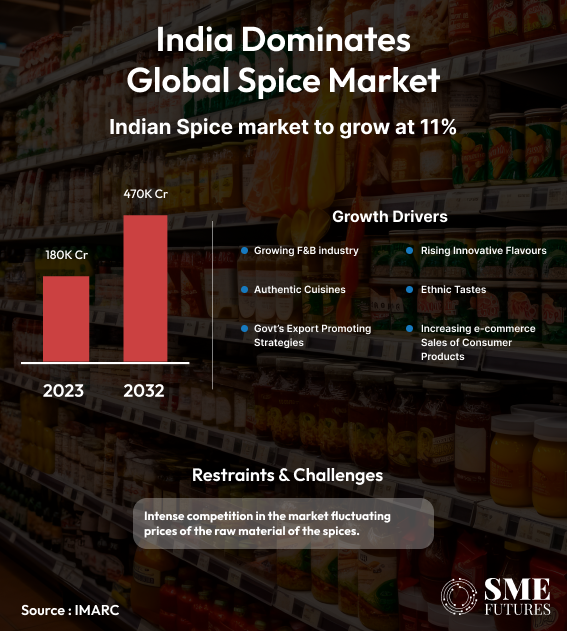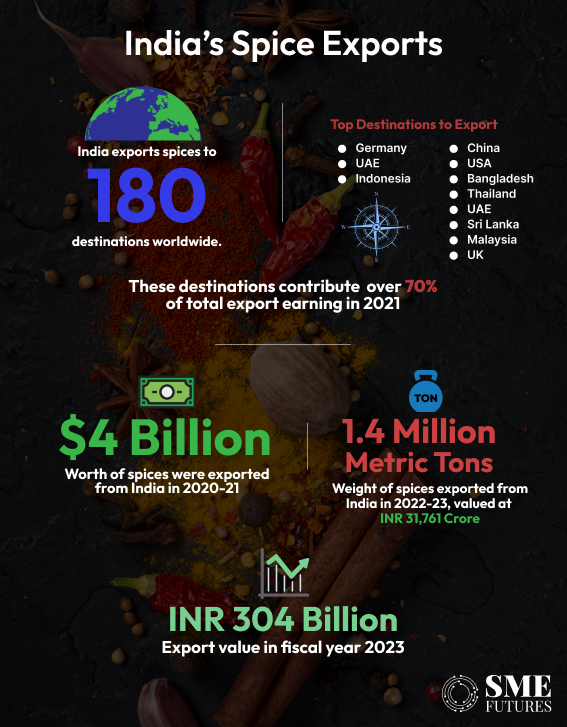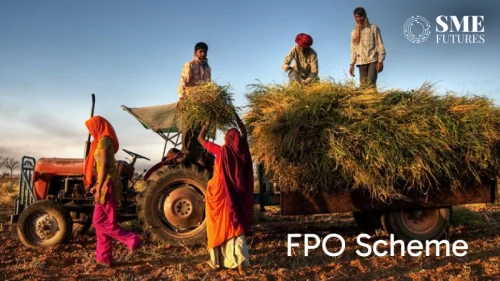The importance of spices in Indian cuisine cannot be overstated. They are the soul of every dish here. But it’s not just within India’s borders that these spices hold sway. They have transcended geographical boundaries to become coveted treasures in kitchens around the globe. Fuelled by escalating demand in the food and beverage sector, spices have evolved beyond mere flavour enhancers, finding applications in the medicinal sector and inspiring continual innovation, including the creation of new blends.
According to IMARC, in 2023, the Indian spices market surged to an impressive Rs 1,80,760 crores. Projections indicate even greater growth, with the market expected to soar to Rs 4,70,339 crores by 2032, exhibiting a robust CAGR of 11% during 2024-2032. This upward trajectory underscores the global appeal of spices, cementing their status as indispensable ingredients in kitchens around the world.
However, recent revelations have cast a shadow over this culinary staple, raising concerns both domestically and internationally. The banning of certain spices from renowned brands like MDH and Everest by international food regulators has sparked a debate that delves deep into the heart of India’s spice industry.
The controversy began with Singapore and Hong Kong’s prohibition of specific spices from MDH and Everest, citing the presence of a potentially carcinogenic substance. Subsequently, the European Union flagged contamination issues in chilli pepper and peppercorn samples from India, alongside nearly 60 other herbs and spices. The ripple effect extended to the United States, where the FDA initiated evaluations of products from these brands, with Australia following suit soon.

Questioning accountability: From field to fork
In the wake of these revelations, The Food Safety and Standards Authority of India (FSSAI) became more stringent on food producers. It started surveying other food items from across categories in view of quality concerns.
Conversely, industry stakeholders have a different perspective on the whole scenario. Naeem Khan, Founder and CEO of Foodys.com, raises pertinent questions about the regulatory oversight both in India and abroad. He highlights the disparity between the stringent approval processes of Western countries and the apparent laxity in India’s regulatory framework. Khan advocates for introspection not only within Indian manufacturing processes but also within the oversight mechanisms governing food safety.
“For long there have been questions on the ingredients that go into these ready masala mixes. Western governments have a far stricter and defined policy on such things. Having said that, the question to be asked is what were their regulatory bodies doing for so long? Every consumable in those countries has to go through a stringent approval process before it can be made available in retail shelves. The brands that are being banned now have been on US and Australian retail shelves for long,” he says.
“While we need to question our manufacturers and their processes and ingredients, we also need to question the regulatory bodies in these countries. FSSAI and other regulatory bodies in India should similarly be questioned on how and why such ingredients were allowed to be made a part of these masala mixes,” he adds.
Root cause is residue
Manohar Malani, a champion of non-toxic crop protection, adds another layer to the discourse. He emphasises the root cause of the contamination, pointing towards pesticide residues in agricultural products. “You have pesticides on the field. The residue of that is getting carried forward,” he says.
He elaborates that the purported cancer-causing substance, ethylene oxide, which food regulators have flagged in the spices, is actually utilised for sterilisation purposes, ensuring their purity by warding off any potential contaminants. But that doesn’t mean that it’s the only thing causing harm, he says.
“What about the chemical pesticide residues present in the masala? None of these sources will remove them. That’s just not feasible because nothing will be effective. So, detecting the source is our only ray of hope. That’s the crux of the issue. So, there’s a genuine concern regarding Indian spices,” he explains.
Malani underscores the interconnectedness of the supply chain, from farms to processing units, shedding light on the challenges of eliminating chemical residues embedded in raw materials. His insights underscore the complexity of the issue, advocating for systemic changes at the grassroots level.
“It’s not something that can be resolved overnight. The primary issue is at the ground level. In fact, even if companies like MDH or Everest adjust, crop residues will not disappear entirely. These residues will persist from batch to batch. Each batch may exhibit different types of residues because they are inherent to the raw material composition, not introduced during processing,” he elaborates.

Navigating towards solutions: A path to sustainability
While the controversy reverberates across borders, the focus has shifted towards viable solutions. Malani proposes a phased transition towards non-toxic farming practices, acknowledging the inherent challenges in an abrupt shift to organic cultivation.
“Going organic is one way, but you cannot go into an abrupt transition. It’s akin to suggesting, ‘Start Pranayama tomorrow, and you’ll never fall ill again.’ Implementing a complete lifestyle change is no easy feat. It’s all about habits and training, isn’t it? I mean, if you outright tell me to change everything I’ve been doing, where would I even begin? And on top of that, what are the implications?” he contends.
According to him, the ecosystem is not ready for such a drastic shift. “It’s just not feasible. We can’t overhaul monocropping overnight. The transition to organic practices is a monumental endeavour. That’s precisely why numerous activists have raised concerns. But the actual conversion happening on the ground is disappointingly low. We need to delve deeper into why the conversion rate remains abysmal. Even if we keep discussing the same issues, we’re essentially beating around the bush without any tangible outcomes. We need a gradual transition plan,” he adds.
But without that, progress will remain stagnant. So, what’s the way forward? we ask him. Malani stresses the need for support mechanisms to facilitate this transition, highlighting the role of larger companies in spearheading initiatives to assist farmers in adopting sustainable practices.
“India’s vast majority of small-scale farmers have limited landholdings and minimal earnings. Transitioning to non-toxic farming practices isn’t easy when livelihoods are at stake. We need to offer support during this transitional phase. Otherwise, farmers will struggle to sustain themselves. Perhaps larger companies like Everest or MDH could allocate resources to support a few farmers in transitioning to non-toxic practices,” he suggests.
Malani says that this collaborative effort could be mutually beneficial. Also, farmers need reassurance that they won’t incur losses during this transition. “By offering support and covering potential income losses, companies can incentivise farmers to embrace sustainable practices. This collaborative approach could pave the way for widespread adoption of non-toxic farming methods, benefiting both farmers and consumers alike,” he asserts.
Similarly, Khan emphasizes the importance of collaboration between industry players and farmers. He suggests a model where brands provide financial support and guidance to farmers willing to embrace non-toxic cultivation methods.
“I think food safety processes are still not up to international standards. While I see an effort by regulatory bodies as well as large brands, I think we have some distance to go. Also, the Indian consumer is mostly lax where safety in food consumption is concerned. For a country that thrives on street food, food hygiene and safety procedures will continue to be out of the main picture,” he says.
This symbiotic relationship, Khan argues, not only ensures the quality of raw materials but also fosters a sustainable ecosystem that benefits both parties.
Amidst the flurry of headlines and regulatory actions, there is a need to distinguish between perception and reality. Both Khan and Malani caution against overblowing the controversy, highlighting the resilience of consumer demand and the transient nature of media cycles. They urge stakeholders to focus on tangible solutions rather than succumbing to sensationalism.
However, the underlying message remains clear – accountability, transparency, and sustainability are non-negotiable facets of India’s spice industry.











